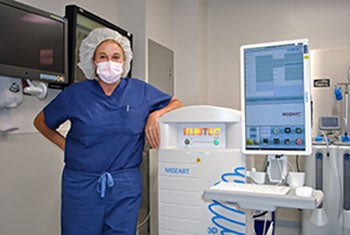Saint Mary's Hospital Installs New 3D Breast Cancer Surgery Technology
September 27, 2021WATERBURY, Conn. (September 28, 2021) Saint Mary’s Hospital has installed a new 3D specimen tomosynthesis imaging system to help breast surgeons better visualize tumors during lumpectomy procedures. Saint Mary’s Hospital is the first and currently only facility in Connecticut using The MOZART® Specimen Tomosynthesis System in the operating room. The MOZART system has been shown to dramatically improve surgeons’ and facilities’ re-excision rate, the rate at which second surgeries need to be performed following a lumpectomy due to positive margins for cancer cells. This capability has taken on greater significance during the COVID-19 pandemic where the ability to limit repeat surgeries and increase operating room efficiency has been recognized as important to promoting a safer environment for patient and clinical care team, alike.
 The MOZART Specimen Tomosynthesis System is a state-of-the art technology that enables the surgeon to visualize the tumor right in the operating room, which no other technology or technique allows. The technology provides clear images of targeted lesions in the specimen, even through obstructions like dense tissue or skin. It creates true 3D images of breast specimens in 1 mm slices during the operation, which enables surgeons to identify the exact location, character, and extent of lesions three-dimensionally. The ability to more accurately confirm the extent of the target excision helps surgeons perform more precise procedures and minimize removal of healthy tissue.
The MOZART Specimen Tomosynthesis System is a state-of-the art technology that enables the surgeon to visualize the tumor right in the operating room, which no other technology or technique allows. The technology provides clear images of targeted lesions in the specimen, even through obstructions like dense tissue or skin. It creates true 3D images of breast specimens in 1 mm slices during the operation, which enables surgeons to identify the exact location, character, and extent of lesions three-dimensionally. The ability to more accurately confirm the extent of the target excision helps surgeons perform more precise procedures and minimize removal of healthy tissue.
Surgeons using the MOZART system during lumpectomy procedures have reported their re-excision rate, or the rate that patients need to return for a second surgery due to positive margins cells, has dropped substantially. The nationally accepted re-excision rate following lumpectomies is 20%, meaning one in five patients will need a second surgery, which can be traumatic and costly. Using the MOZART in the operating room has helped surgeons reduce this rate to around 5%. *
This increased precision and efficiency are key advantages when performing breast cancer surgeries during the COVID-19 pandemic. New guidelines from the American Society of Breast Surgeons (ASBrS) and other leading surgical associations recommend delaying re-excision procedures until the pandemic is over. This means patients who need a re-excision face an extended wait before they can have their cancer fully removed.
“A 20% re-excision rate following a lumpectomy procedure is too high,” said Beth Sieling, M.D., Trinity Health Of New England Breast Surgeon. “However, achieving what are known as ‘clean’ or ‘negative’ margins, where no cancer cells are left at the outer edge of tissue removed during a lumpectomy procedure, is not simple. Surgeons must decide how much tissue to remove from around the tumor. This system can help even the most skilled surgeons reduce their re-excision rate.”
Dr. Sieling continued, “The use of technologies in the operating room help limit potential exposure to COVID-19 by improving a surgeon’s efficiency and minimizing the time patients spend in healthcare facilities. Moreover, the ability to improve surgical precision and reduce the need for a potential re-excision is paramount given the limitations on repeat surgeries during the COVID-19 pandemic.”
The MOZART System also saves time in the operating room because the surgeon does not have to wait while a specimen is taken to a separate radiology area for analysis. Studies show that using the MOZART System during surgery can reduce a lumpectomy procedure by as much as 15 minutes, which for a patient means less time under anesthesia.
Dr. Steven Schneider, president of Saint Mary’s Hospital said, “Our breast cancer center provides advanced care, individualized service and an exceptional patient experience. Saint Mary’s is the first in Connecticut to install three-dimensional breast specimen tomosynthesis technology for use in the operating room. We are pleased to be leaders in the quality of care for breast cancer care patients, and the acquisition of MOZART is a key part of our dedication to this goal.”
About Saint Mary’s Hospital
Saint Mary’s Hospital is a Catholic, not-for-profit, acute care, community teaching hospital that has served Greater Waterbury since 1909. In 2016, Saint Mary’s Hospital became part of Trinity Health Of New England, an integrated health care delivery system that is a member of Trinity Health, Livonia, Michigan, one of the largest multi-institutional Catholic health care delivery systems in the nation serving communities in 22 states. Licensed for 347 beds, Saint Mary’s is designated as a Level II Trauma Center, offers award-winning cardiac and stroke care and houses the region’s only pediatric emergency care unit. As the leading provider of surgical services in Greater Waterbury, Saint Mary’s was the first to introduce the daVinci® Robotic Surgery System. The hospital’s satellites and affiliates extend from Waterbury to Wolcott, Cheshire, Naugatuck, Southbury, Prospect and Watertown. Visit stmh.org for more information and follow us on Facebook at SaintMarysHospitalCT, Instagram and Twitter at @SaintMarysCT.
